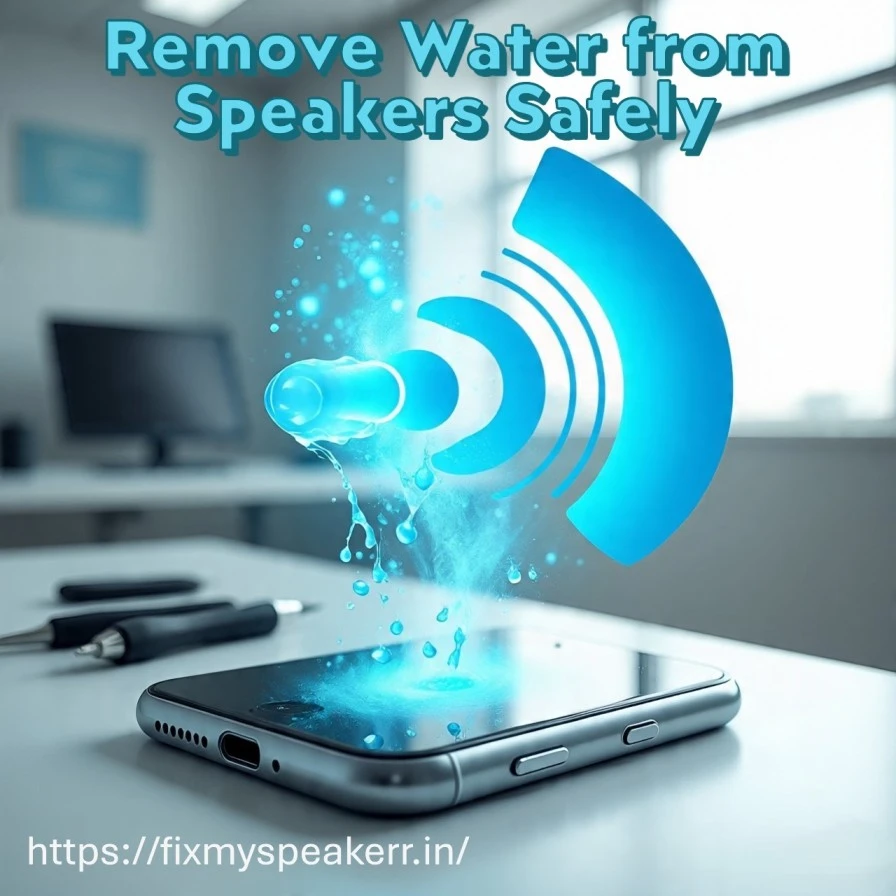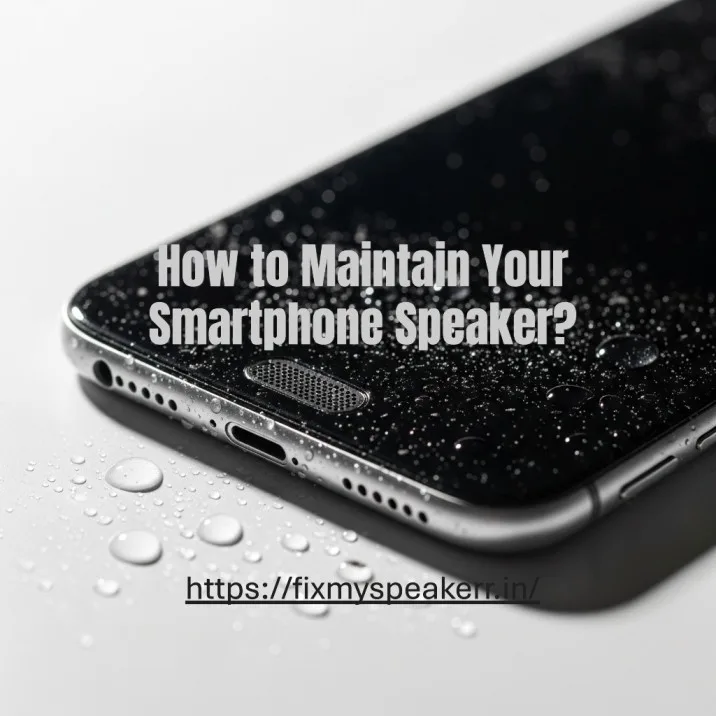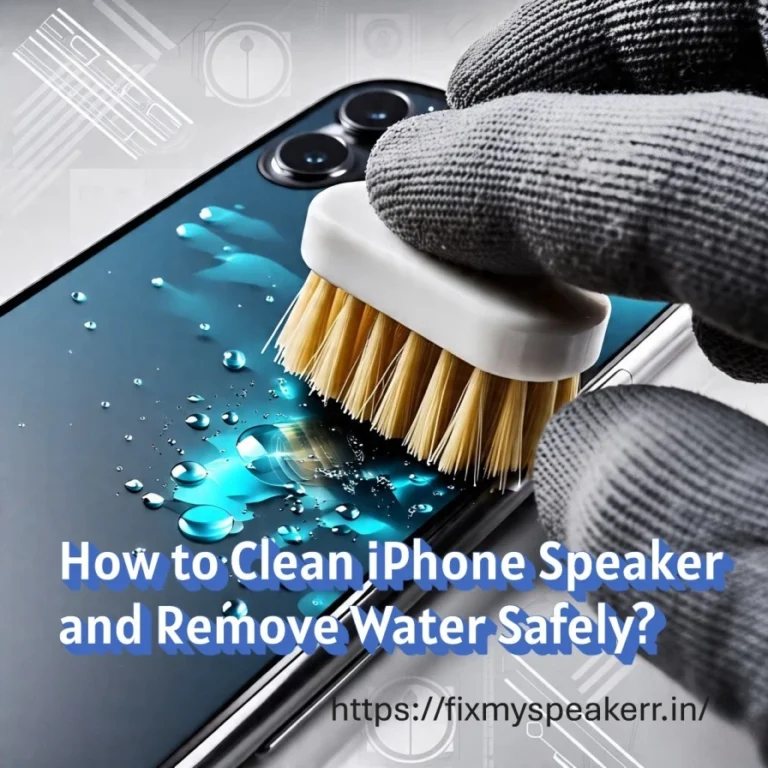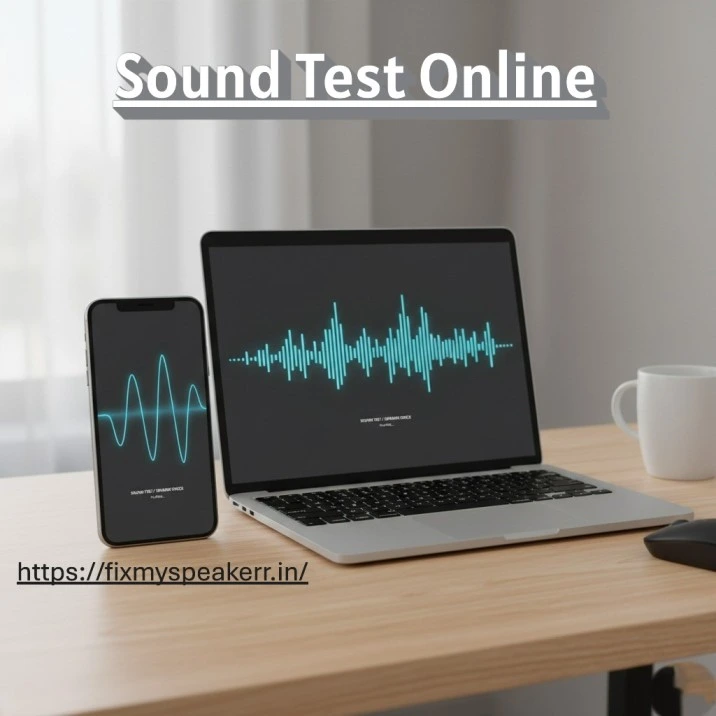Why Water in Your Speaker Is a Real Problem?
Water in your speaker can cause muffled sound, short circuits, or permanent damage if not removed quickly. Identifying moisture early helps prevent audio issues and costly repairs.
Water Can Damage Speaker Components
When water in speaker parts isn’t removed quickly, it may cause short circuits, reduce sound quality, or permanently damage internal components.
How to Identify Moisture in Your Speaker?
If your phone speaker or Bluetooth speaker sounds muffled, distorted, or quiet, it’s likely water is trapped. This is when users often search for terms like “my speaker fix”, “my phone speaker not working”, or “water in speaker sound”.
Common Symptoms of Water in Speakers
- Muffled my speaker sound
- Crackling or buzzing sound speaker water
- Distorted audio from mobile speaker
Why Immediate Action Matters?
Leaving water inside increases the risk of corrosion and full audio failure. Using tools like water eject sound, water speaker cleaner, or silica gel packets can help safely remove water from speaker components before damage becomes permanent.
🔊 Fix My Speaker
Remove water & dust with sound frequencies
⚠️ Safety Disclaimer
- Keep volume at moderate levels to prevent speaker damage
- Do not use if you have hearing sensitivity or medical conditions
- Stop immediately if you experience discomfort
- Not recommended for damaged or very old speakers
- Results may vary depending on speaker type and damage extent
💡 Pro Tips
- Place device face down on a soft towel for water removal
- Use Water Mode for liquid ejection (slower frequencies)
- Use Dust Mode for particle removal (higher frequencies)
- Repeat process 2-3 times for best results
- Allow speaker to dry completely after water cleaning
Signs You Need to Clean or Fix Your Speaker
If your speaker sounds muffled, distorted, or quiet, it may be due to trapped water or dust. Recognizing these signs early can help you fix speaker issues before they become permanent.
Muffled or Distorted Sound Output
If my speaker sounds muffled, quiet, or unclear after water exposure, it’s a strong indicator of moisture trapped inside. Common phrases users search include “fix my spekar”, “my speaker fix”, and “fix my speaker” all pointing to water interference with speaker vibration and audio output.
Buzzing, Cracking, or Low Volume
A wet speaker may produce a crackling sound, inconsistent volume, or strange vibrations. You might notice “sound speaker water” or “water in speaker sound” these issues suggest water is obstructing sound flow through the speaker mesh or diaphragm.
Speaker Stops Working Suddenly
In some cases, the phone speaker or Bluetooth speaker goes completely silent. Users report issues like “my phone speaker not working”, “fixmy speaker”, or “my speaker clean”, all due to possible water damage.
Phone Thinks It’s Still Wet
Your device may disable audio or show water alerts. Apps such as “check my speaker”, “set my speaker”, or “speak my speaker” are often used to verify speaker function before and after cleaning.
Dust Mixed with Moisture Blocks Output
Water mixed with dust inside the speaker port can block sound. In these cases, sounds like “call speaker dust cleaning sound” or “ear speaker dust cleaning sound” are used to dislodge particles safely.
How to Remove Water from Speaker?
Removing water from your speaker safely restores clear sound and prevents long-term damage. Follow these proven methods to dry out your device without causing harm.
Power Off the Device Immediately
If you suspect water in speaker, turn off your phone or Bluetooth speaker to prevent internal short circuits. Avoid using it until the issue is resolved.
Let Gravity Help
Hold the phone upright, speaker side facing down. This allows water out of speaker naturally. Avoid shaking the device aggressively as it may push moisture deeper.
Use Dry Cloth and Airflow , Not Heat
Dry the outside gently with a lint-free cloth. Let air circulate by placing the device near a fan—not under heat. Avoid hairdryers. For extra help, use speaker air movement from speaker dust cleaning sound tools.
Place in a Drying Environment
Use silica gel packets (preferred over rice) to absorb trapped moisture inside the speaker. These help remove hidden mobile water from delicate internal parts.
Use Sound Based Water Ejection Tools
Play water removal sound or water cleaner sound at the correct frequency (around 165Hz–440Hz) to push water out using speaker vibration. Trusted tools include:
- fix my speaker water
- water out of speaker sound
- speaker water remover
- phone water cleaner
- mobile water cleaner
Try Verified Speaker Cleaner Apps
You can also use phone speaker cleaner sound apps that play pulsing tones to eject water. Examples include:
- fixmyspeaker
- speaker cleaner
- water remove from speaker
These tools are widely searched as “fix my speker”, “my fix speaker”, or even “fx my speakers”. Always use them on low volume first, then increase gradually.
Be Patient Drying Takes Time
Depending on the amount of exposure, it may take several hours to fully remove water from speaker. Avoid rushing with high volume or force.
Use Sound to Eject Water from Your Speaker
Using specific sound frequencies can effectively push water out of your speaker grills. This safe, non-invasive method helps restore audio clarity without opening your device.
What Is a Water Eject Sound and How Does It Work?
A water eject sound is a specific frequency—usually between 165Hz and 440Hz—that creates speaker vibration, helping force water out of speaker grills. This method is popular among users searching terms like “fix my speaker water”, “water remove sound”, or “speaker cleaning sound”.
Best Tools and Websites to Use
There are several free and paid tools online that safely push water out using sound pulses. Trusted options include:
- fixmyspeakerr.in
- fix my speaker.com
- water speaker cleaner
- speaker cleaner
- speaker clean sound
These tools are simple: press play, aim the speaker downward, and let the tone run for 30–60 seconds.
Mobile Apps for Phone Water Removal
For smartphone users, mobile-optimized tools like:
- phone water remover
- mobile water sound
- phone speaker cleaner sound
- water cleaning sound
These apps are often searched with phrases like “my speaker clean”, “water cleaner”, or “water remove speaker” and are available for both Android and iPhone.
Does It Work for All Devices?
Yes, these tones work for most smartphones, Bluetooth speakers, and even ear speaker dust cleaning sound. Just ensure the speaker is facing down during playback.
How Long Should You Run the Sound?
Run the sound in 30–60 second intervals, then test the speaker. Repeat if the audio still sounds muffled. Tools like “call speaker dust cleaning sound” or “water beep sound” are commonly used in short bursts.
Using water ejection sound is one of the safest and most effective ways to remove water from speaker without opening the device or causing damage. It’s quick, free, and widely used by millions.
Best Speaker Cleaner Apps and Sound Tools
Speaker cleaner apps use sound waves to remove water, dust, and debris from your device speakers. Explore the best tools to fix muffled audio and restore clear sound quickly.
What Are Speaker Cleaner Apps?
Speaker cleaner apps are mobile tools that play high-frequency speaker cleaning sound or low-pulse tones designed to eject moisture, dust, and debris. They’re popular solutions for users searching “fix my speaker”, “speaker water cleaner”, or “water clean speaker”.
Top Rated Tools
Users Search and Use Some of the most used apps and sites include:
- fix my speakerr.in – plays a water remove sound with optimized frequency
- fixmyspeaker – simple interface, one-tap water ejection
- speaker clean sound – powerful pulsing to loosen trapped water
- water removal sound – a frequency sweep for moisture clearing
- mobile water cleaner – tailored for Android and iPhone devices
- phone water remover – fast action for phone speaker not working issues
These tools help clean not only the main speaker but also the ear speaker and call speaker, improving clarity after water exposure.
Specialized Sounds That Help
Some apps include extra options like:
- call speaker dust cleaning sound
- ear speaker dust cleaning sound
- water speaker sound
- water beep sound
- water vibration modes
- sound speaker water tone boosters
These terms are frequently searched by users trying to resolve muffled or distorted audio after water contact.
Safety Tips for Using These Tools
- Start with low volume and increase gradually
- Always face the speaker downward
- Avoid using with headphones connected
- Use apps for short cycles (30–60 seconds), then retest
Using trusted speaker cleaner apps with optimized water removal sound is one of the easiest and safest ways to remove water from speaker systems—without disassembling your phone or speaker.
How to Fix Muffled or Non Working Phone Speakers?
If your phone speaker sounds muffled or stops working, moisture or debris may be the cause. Use targeted cleaning sounds and simple fixes to restore normal audio performance.
Identify the Issue First
If my speaker sounds muffled, crackles, or has no output after water exposure, you’re likely dealing with internal moisture or blocked audio pathways. Many users search for solutions using terms like “fix my speaker”, “fix my spekar”, or “my speaker fix”.
Use Water Ejection and Dust Removal Tools
Run a phone speaker cleaner sound or water out of speaker sound using apps like fixmyspeaker or fix. my speaker. These tools generate specific tones to force water and dust out of the speaker port.
Combine it with sounds like:
- water removal sound
- water cleaner sound
- call speaker dust cleaning sound
These tools are helpful especially when your mobile speaker or ear speaker produces a dull or weak tone.
Reset Audio Settings or Volume Profiles
Try using commands like set my speaker, fit my speaker, or speak my speaker through device apps or settings to restore normal output if distortion continues.
You may also toggle the audio settings, clean output profiles, or restart the phone in safe mode to reset audio drivers.
Check for Physical Blockage or Dirt
Dust can mix with moisture and create a sound barrier. Use speaker air from compressed air cans (gently) or apps with speaker dust cleaning sound to dislodge particles.
Apps like my speaker clean or mobile water cleaner are useful when physical cleaning isn’t an option.
When to Seek Professional Help?
If your phone speaker not working even after using all sound-based tools, it may be due to corrosion or hardware damage. In such cases, it’s best to visit a certified technician to avoid further damage.
Fixing a muffled speaker requires patience and the right tools. By using a combination of speaker cleaner apps, proper drying, and system resets. Most water related audio problems can be resolved safely without opening the device.
How to Remove Water from Bluetooth Speakers Safely?
Water in Bluetooth speakers can cause distorted sound or complete failure if not addressed quickly. Follow these safe and effective steps to remove moisture without damaging your speaker.
Power Off Immediately
If your Bluetooth speaker gets wet, turn it off right away. Continued use can short internal circuits and permanently damage the speaker.
Drain Water with Gravity and Positioning
Hold the speaker so the water out of speaker direction faces downward. Let gravity help drain the liquid without forcing air or shaking it.
Use Water Ejection Sounds Designed for Speakers
Play a water remove sound or speaker clean sound using trusted tools such as:
- speaker water remover
- fix my speakerr.in
- water speaker sound
- fix my speaker water
- speaker cleaner
- phone water cleaner (if connected via mobile)
These emit sound frequencies that help push water out via controlled speaker vibration.
Let It Air Dry or Use Absorbents
After using sound tools, let the speaker air-dry in a warm (not hot), ventilated area. Place silica gel packets nearby to absorb moisture. Avoid heat sources like ovens or dryers.
Avoid These Mistakes
- Don’t insert sharp objects into speaker grilles
- Don’t use a hairdryer, as heat may damage internal glue or seals
- Avoid vacuum cleaners or strong air pressure
Test After 24 Hours
After drying, connect your Bluetooth speaker and test using a speaker cleaning sound app. If the sound is still unclear, repeat the process or seek repair.
Water resistant doesn’t mean waterproof forever. Even IP rated speakers can retain moisture after extended exposure. Using water removal sound tools and proper drying methods can often fix the issue without opening the device.
What Not to Do When Your Speaker Gets Wet?
Avoid common mistakes like using heat or poking the speaker, which can worsen the damage. Knowing what not to do is crucial to safely recover your wet speaker and protect its components.
Don’t Use Heat Sources
Avoid drying your device with a hairdryer, microwave, or placing it in direct sunlight. High heat can melt internal components or damage adhesives in your phone speaker or Bluetooth speaker.
Don’t Insert Sharp Objects into the Speaker
Grill Poking your speaker with pins, clips, or cotton swabs can damage the diaphragm. This is a common mistake by users searching “fix the speaker” or “speaker killing” methods, which often make the issue worse.
Don’t Shake the Device Aggressively
Shaking may push water deeper into the speaker chamber or other internal circuits. Instead, use gravity-assisted positioning and water eject sound tools like fixmyspeaker or speaker water cleaner.
Don’t Use Untrusted Apps or Fake Tools
Avoid tools with misspelled names like “fix my spekar”, “fx my speakers”, or “fix. my speaker” from unreliable sources. They may harm your device or do nothing at all.
Don’t Ignore Ongoing Distortion or Silence
If your mobile speaker continues to sound muffled after using tools like water cleaning sound or speaker fix, stop using it and let it dry longer or seek help. Forcing more audio may worsen the issue.
Don’t Assume Waterproof Means Water-Problem-Free
Even if your phone or Bluetooth speaker is water-resistant, moisture can still enter the speaker mesh. Always take precautions and use water removal sound or phone water remover apps if you notice a change in sound quality.
Taking these precautions prevents permanent damage and improves your chances of fully recovering your speaker sound.
Safe handling + correct tools = best results
Conclusion
If you get water in speaker components, act quickly to avoid damage. Use safe tools like fix my speaker, speaker cleaner, or a water eject sound to remove water from speaker grills. Apps like fixmyspeaker, phone water remover, and water cleaning sound help restore clarity without opening the device. Avoid heat or poking, and let silica gel packets absorb moisture. Whether it’s a Bluetooth speaker, phone speaker, or mobile speaker, proper steps can fix muffled audio safely.
FAQs About Removing Water from Speaker
Complete FAQ guide to safely remove water from your speakers




